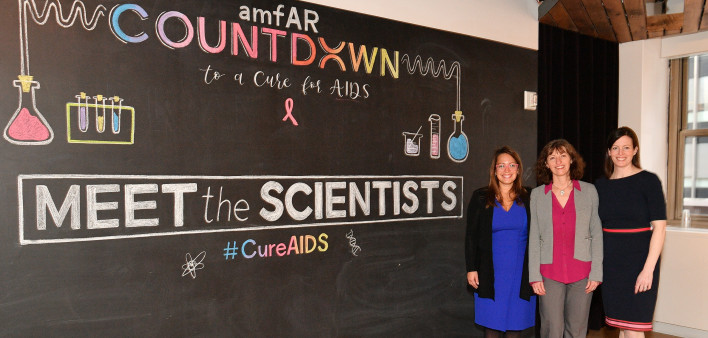How do differences between the sexes affect the HIV reservoir, and does clinical research include enough women? Exploring such questions is a necessary part of finding a cure for HIV. They were also the topic of an all-female panel titled “Meet the Scientists: Women and HIV Cure Research” held March 28 in New York City by amfAR, The Foundation for AIDS Research. Watch a video about the event below:
Held in honor of Women’s History Month, the panel discussion was moderated by Rowena Johnston, PhD, vice president and director of research at amfAR. The panelists included Galit Alter, PhD, of Harvard Medical School, and Eileen Scully, MD, PhD, of Johns Hopkins University.
“The fastest-growing population of people with HIV in the world is young girls in sub-Saharan Africa,” said Scully during the panel, according to amfAR’s coverage of the event. “We cannot pretend we’re moving forward with an HIV cure agenda that’s going to help the whole world unless it works in both men and women.”
Scully has been researching the male-female sex differences in the HIV reservoir, the virus that hides out in the body, dormant, and is unreachable by antiretrovirals.
“There’s not a lot of research in the cure space on female-male differences,” said Alter. “The most revelatory change occurred two or three years ago when the NIH [National Institutes of Health] made it necessary that you had to explicitly state how many females and males you include in every one of your studies and had to justify if you didn’t balance your genders in every single study.”
“There are real differences that are both scientifically useful and therapeutically important,” added Scully. “I also think token inclusion of women is a really dangerous path, where there’s five women in a study of a hundred people and the conclusion is that women are the same as men.”

The all-female panel at amfAR’s Cure for AIDS event titled “Meet the Scientists, Women and HIV Cure Research”Courtesy of amfAR
The panelists also spoke about their experiences as women in the research field.
“There are fewer and fewer women as you move up the ranks of seniority in science,” Johnston noted. “Grants to women are smaller, and women are underrepresented in the most prominent positions of scientific authorship and as conference speakers.”
“Times are changing,” Alter said, striking an optimistic note. “We have so much more female faculty, we have so much more female representation on study sections, on peer review for journals.”
Johnston was recently seen in global reports like this CBS News video discussing amfAR’s involvement in the case of “the London Patient,” a man whose HIV is apparently in remission. For further background, read the POZ article “A 2nd Man’s HIV Is in Long-Term Remission, but Is He Cured?”







2 Comments
2 Comments